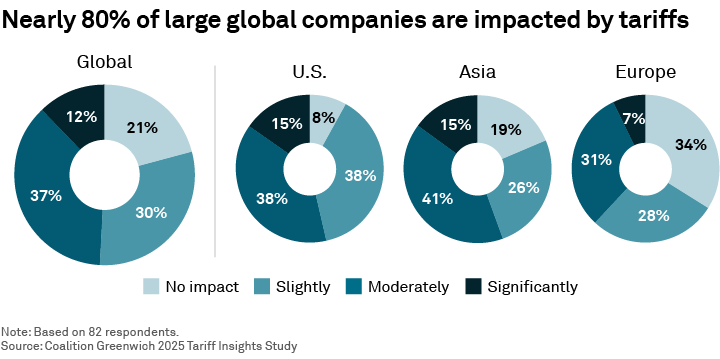
Companies around the world are holding off on major strategic adjustments like shifting production to the United States or making other changes to global supply chains until they have more clarity about which of the Trump administration’s on-again, off-again tariffs will remain and which will be rolled back in negotiations. Over the longer term, however, companies are preparing to take steps, such as adjusting customer prices and even finding alternative markets for their products, if steep tariffs remain in place.
Almost 80% of large companies participating in a new study by Crisil Coalition Greenwich say repeated changes in tariff policies have affected their business strategies.

The study results show that the back-and-forth on tariffs has had a significant effect on companies in the U.S. and Asia, while having a more muted impact on large companies in Europe. More than 90% of companies in the U.S. and 80% in Asia say tariff announcements have affected their businesses, compared with 66% in Europe.
Those overall numbers actually understate the impact of tariffs on large, international companies. Among companies in all three regions that do business in the U.S., nearly 9 out of 10 say new tariff policies have affected their businesses. Among these companies, approximately 35% say tariff announcements have already impacted supply chain corridors and/or logistics strategies.
Across all corporates, companies in consumer-facing industries, including consumer discretionary and staple sectors, and industrial and energy sectors are the most likely to report tariff effects, at roughly 90%.
Companies plan response
To get a better understanding of how companies are reacting to new tariffs, we asked companies that do business in the U.S. about strategies they are implementing or planning to implement in response to the shifting trade policies. A significant share of these companies, roughly 43%, are taking a “wait and see” approach to the tariffs, meaning they are not making any adjustments to strategy until they have a better idea of how negotiations between the Trump administration and other governments play out. That approach seems to have been at least partially vindicated on May 12, when the U.S. agreed to slash its 145% tariff on Chinese goods to 30% in exchange for a comparable move from the Chinese government for a 90-day negotiation period.
However, the study results also include some bad news for the U.S. consumer: More than 40% of companies around the world that do business in the U.S. say they are implementing or planning price adjustments, implying that at some point, they intend to pass along some tariff costs to customers.
We’ll take a deeper dive into strategies companies are employing in response to U.S. tariffs in our next blog post.

